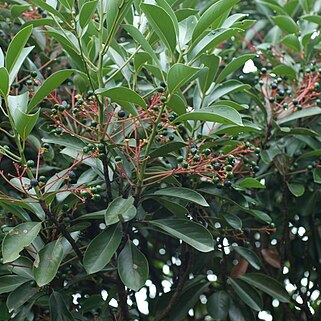Shrubs or small trees. Branchlets blackish brown when dry, 4-or 6-angled. Leaves opposite or ternate; petiole ca. 2 mm; leaf blade broadly elliptic, elliptic, orbicular, obovate, or broadly obovate, 1-3 × 0.5-2(-2.2) cm, leathery, abaxially slightly pale when dry, adaxially dark brown and not glossy when dry, abaxially glandular, secondary veins numerous, 1-1.5 mm apart, abaxially slightly raised, and adaxially inconspicuous or depressed, intramarginal veins 1-1.5 mm from margin and depressed or not, base broadly cuneate, cuneate, or obtuse, apex rounded, obtuse, or acute and sometimes with an obtuse cusp. Inflorescences terminal, cymes, ca. 1 cm, several-flowered. Flower buds ca. 3 mm. Hypanthium obconic, ca. 2 mm. Calyx lobes shallow wavy. Petals 4, white, distinct, ca. 2 mm. Stamens ca. 2.5 mm. Style as long as stamens. Fruit red turning purplish black, globose, 5-7 mm in diam. Fl. Jun-Aug, fr. Oct-Dec.
More
An evergreen shrub. It grows 1-3 m high. It is compact and has dark green leaves. The young branches are 4 angled. The leaves are opposite, leathery and broadly oval. They are 2-4 cm long by 2 cm wide. The base is wedge shaped. The flowers are small and white. They are in groups in the axils of leaves and at the ends of branches. They do not have a leaf stalk. The fruit are round and shiny black when ripe. They are 8-12 mm across. There is one seed.
It is a subtropical plant. It is native to Hong Kong and China. It grows in open forest and in mountains. It grows from 200-1,200 m above sea level. It grows in areas with a temperature about 17°C. In Sichuan.

